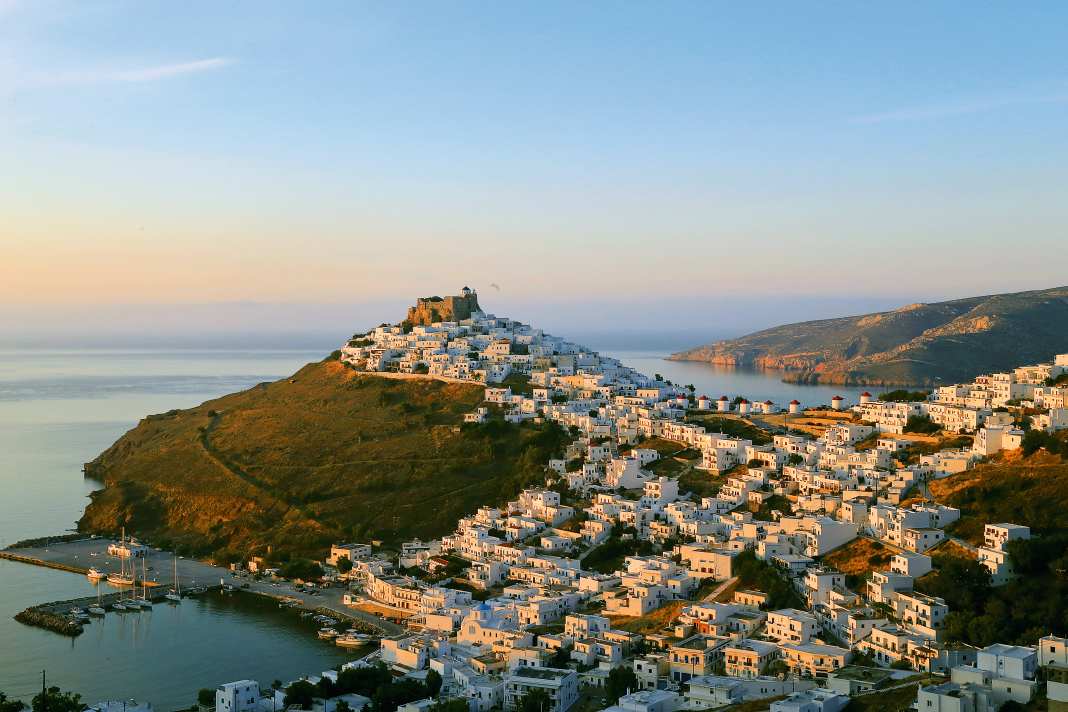





Greece is a top destination for island hopping. Whether it's the Aegean or the Ionian Sea, there's always something appealing to be found. However, a few Greek islands are very special, such as Astipalaia.
Because of its shape with two broad land masses and the centre of a narrow land connection, this island on the western border of the Dodecanese is also known as the "Butterfly Island". It lies somewhat off the charter routes, and only a few crews sailing in the otherwise short-haul Dodecanese visit it, as the distance of around 35 miles is too far for them. The same applies to crews travelling in the Cyclades. That's why you often only meet a few sailors on Astipalaia. Tourism is not as dominant here as on some other islands and there are no over-the-top party areas. Astipalaya shows a pleasantly down-to-earth side of Greece.
The main town is spectacularly situated on a mountain, including an old fortress and windmills on a hilltop. White cube-shaped houses nestle on the slopes around the dark stone castle at the top. At the foot of the mountain is the small island harbour, which can accommodate perhaps a dozen yachts at the bow anchor (water and electricity available). A similar number can anchor next to or in front of it. Alternatively, there is a good anchorage south of the old town in front of a beach. The town is a maze of alleyways that are a labyrinth on the steep, sweat-inducing climb and only occasionally offer a view of the Aegean Sea and the sea of houses on the mountainside. Cafés, bars, restaurants - everything is there, but somehow more relaxed than on many other islands in the Dodecanese or the Cyclades. A place that needs to be explored.
Click here for the other parts of our "Five perfect islands" series:
- Greece: Five perfect islands - Part 1: Kalymnos
- Greece: Five perfect islands - Part 2: Paxos
- Greece: Five perfect islands - Part 3: Astipalaia
- Greece: Five perfect islands - Part 4: Milos
- Greece: Five perfect islands - Part 5: Syros
Sailing to Astipalaia is not for the faint-hearted
Once this is done, you can explore the island by boat. Sail into one of the beautiful, secluded bays in the south with crystal-clear water and spend the day swimming, lazing around and taking short excursions on mountain ridges or beaches. Agrilidi in the south-east or the small neighbouring island of Koutsomyti are such magical places. If you climb the hills there, the water shines in the most beautiful turquoise and behind it the deep blue that somehow only the Aegean can achieve. Or you can anchor south of the main town in the shelter of the peninsula and fortify yourself at the very nice beach restaurants and bars, recharging your batteries for the return journey to Kos, where most charter crews start. Often a half-wind or 60-degree course in crisp Meltemi. Astipalaia is not for the faint-hearted. The north of the island offers few good spots, with the exception of the secluded, inland sea-like bay of Vathy, which offers perfect shelter after an entrance that is less than 100 metres wide (watch out for a 2.8 m shallow section!).
How to get there
Most crews sail over from Kos, a beat of about 35 miles. Alternatively, 80 miles from Rhodes, but the charter fleets there are not as good as on Kos. In any case, Astipalaia should generally only be included in a 14-day trip; it would be a shame to skip the closer Dodecanese islands.
Worthwhile excursions
The castle of a Venetian family from the 15th century at the top of the mountain is just an uninhabited ruin, except for two chapels. It's worth the climb, the view is fantastic! (www.kastra.eu) In the beautiful Agrilithi anchorage, a sunken cargo ship lies just below the waterline in the western tip in front of the dilapidated factory. Worth a dive!
Restaurant tips for Astipalaia
The "Agoni Grammi" restaurant at the top of the Grad next to the windmills is a very good choice. In the evening, the "Athelas" bar offers a great view over the harbour. If you want to enjoy the view of the city during the day and after sunset, you can stop for dinner at "Antikastro" on the other side of the harbour entrance.

